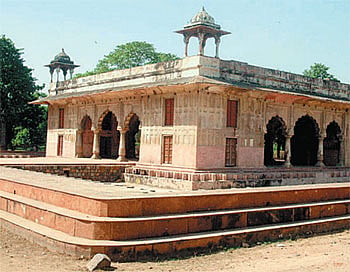If you walk along the Roshan Ara Road near the Old Sabzi Mandi in Delhi, you will come across what once used to be the garden of Princess Roshan Ara, the daughter of Shah Jahan and the younger sister of Princess Jahan Ara.

It is now a beautiful, landscaped park with a striking Japanese garden belonging to the Roshan Ara Club built during the British Raj. In a corner of the green expanse lies a neglected tomb. It is the tomb of Princess Roshan Ara. The garden, however, was not meant to house the tomb of its creator when it was first made. It is the irony of fate that it should be remembered as such. Or some might call it divine retribution.
After the Red Fort was built, the royal family moved from Agra to take up residence in the newly built city of Shahjahanabad. The members of the royal family got busy with the creation of new palaces and buildings for their new capital. Princess Jahan Ara, the favourite daughter of the emperor, had already laid out Chandni Chowk and Begum ka Bagh. It was now Roshan Ara’s turn. She laid out the Roshan Ara Garden in 1650. She was the favourite sister of Aurangzeb, who grabbed the throne some years later and imprisoned his father. Jahan Ara shared her father’s captivity and also his sorrow.
Roshan Ara actively supported Aurangzeb in the war of succession. As a result, she played an important role in Aurangzeb’s court. In fact, she was the sole mistress of the palace and enjoyed all the privileges of a queen. With unlimited wealth at her disposal and her brother’s total support, Roshan Ara saw to it that her garden was far more spectacular than her sister’s. Jahan Ara had meant her garden to be a place where not just the royal family but also the ladies of the court could relax and enjoy themselves.
Roshan Ara’s garden was her personal holiday resort and her special summer house.
Travellers who visited Delhi during the period have written about the Roshan Ara Garden in their memoirs. A writer of that time says: “It must have been a gay sight when Begum Roshan Ara’s elephant procession arrived here from the Delhi Fort. The huge animals, with their gold-embroidered coverings, their solemn tread, their jingling silver bells and then, the princess herself, escaping from the noise and heat of the royal palace, came in her splendid rose-curtained seat, swung between two smaller elephants, to while away a few hours in her cool, flower-scented, fountain-sprinkled garden.”
But the garden eventually proved to be more than a pleasure resort for Roshan Ara. Those familiar with the history of the Mughal family cannot but realise that it is not men alone who go crazy over the tussle for power. Sometimes even women lose their heads (and moral scruples) in the power game. This is precisely what happened to Roshan Ara. She was completely taken in with the power she had enjoyed thus far and wanted it to go on forever, even if it meant treachery of the worst kind.
Aurangzeb fell seriously ill in 1664. So much so that the royal family wondered if he could possibly survive. The next in the line of succession was Shah Alam, the eldest son of Aurangzeb, who was the rightful heir. But Roshan Ara realised that she would no longer continue to enjoy the same kind of privileges once Shah Alam became the emperor. So, she was determined to prevent it no matter what she had to do to ensure it. She was so confident of her own ability and cleverness that she stole Aurangzeb’s signet ring while he was too ill to realise the loss. Then, she hatched a clever plot to replace Shah Alam with his six-year-old brother Azam. This would mean that Roshan Ara would continue to enjoy total power and supremacy as the regent until Azam grew up and was old enough to be crowned emperor. Roshan Ara dared to carry out this plan because she was confident that Aurangzeb would die and never discover that the order to replace Shah Alam had been forged by her.
But Aurangzeb recovered from his illness and discovered her plot. Needless to say, he was livid with rage when he realised that the sister whom he had loved, trusted, and to whom he had given so much could do such a thing. Roshan Ara lost her position immediately. Not long after, she passed away. She was buried in her own garden of pleasure. Perhaps, she took her own life or was poisoned by a supporter of Aurangzeb. Whatever it might have been, her favourite pavilion is now her grave.
The Roshan Ara Garden was grossly neglected until Colonel Cracroft took it up and renovated it. He had all the ruined Mughal structures pulled down. Everything except the tomb itself. The new garden became the fashionable Roshan Ara Club, a favourite meeting place of the British during their reign. The landscape has totally changed now. All that remains of its Mughal past is the name and the legend of Roshan Ara.
